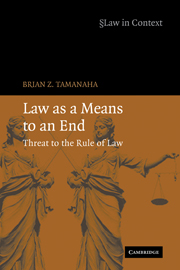Book contents
- Frontmatter
- Contents
- Acknowledgments
- Introduction
- Part 1 The spread of legal instrumentalism
- Part 2 Contemporary legal instrumentalism
- 6 Instrumentalism in legal academia in the 1970s
- 7 Instrumentalism in theories of law
- 8 Instrumentalism in the legal profession
- 9 Instrumentalism of cause litigation
- 10 Instrumentalism and the judiciary
- 11 Instrumentalism in legislation and administration
- Part 3 Corroding the rule of law
- Epilogue
- Index
- Titles in the series
10 - Instrumentalism and the judiciary
Published online by Cambridge University Press: 25 July 2009
- Frontmatter
- Contents
- Acknowledgments
- Introduction
- Part 1 The spread of legal instrumentalism
- Part 2 Contemporary legal instrumentalism
- 6 Instrumentalism in legal academia in the 1970s
- 7 Instrumentalism in theories of law
- 8 Instrumentalism in the legal profession
- 9 Instrumentalism of cause litigation
- 10 Instrumentalism and the judiciary
- 11 Instrumentalism in legislation and administration
- Part 3 Corroding the rule of law
- Epilogue
- Index
- Titles in the series
Summary
Political scientist Nathan Glazer, in 1975, asked whether the U.S. polity had permanently shifted “Towards an Imperial Judiciary?” The “Court is committed to an activist posture, with great impact on various areas of life. … [and the Court is] simply legislating its views on difficult problems.” In the quarter century since Glazer posed his question, the assertive stance of courts has increased, according to many observers. Armed with the power of judicial review, and prompted by cause litigation, by rights cases, and by the interpretation of far-reaching legislation, judges increasingly make decisions that penetrate all aspects of social life. At the end of the twentieth century, said Robert Bork, “It is arguable that the American judiciary – the American Supreme Court, abetted by the lower federal court and many state courts – is the single most powerful force shaping our culture.” There are reasons to doubt that courts are as efficacious in this effort as Bork suggests, but there is no doubt that his view is widely shared.
Conservatives have been exercised at courts for decades for these actions. To the delight of conservatives, of late, liberals have also begun to protest the assertiveness of courts. Since the 1960s, liberals have reposed faith “in the courts as vehicles for social change.” Now that conservative appointments appear likely to dominate the federal judiciary for the coming generation, prominent liberals have begun to join conservatives like Bork in proposing that the power of judicial review be curtailed or abolished.
- Type
- Chapter
- Information
- Law as a Means to an EndThreat to the Rule of Law, pp. 172 - 189Publisher: Cambridge University PressPrint publication year: 2006
- 2
- Cited by

